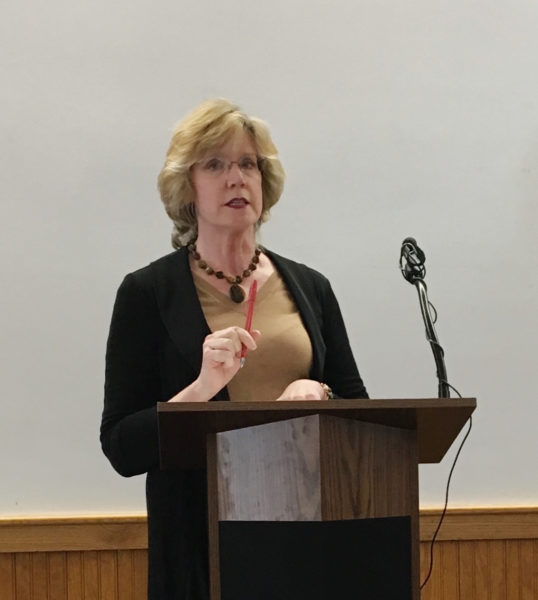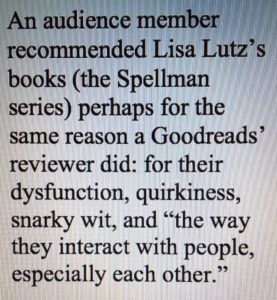
- This event has passed.
Five Common Mistakes Writers Make
January 8, 2017, 2:40 pm - 4:00 pm

From looking at thousands of manuscripts over the last decade, Belea Keeney has identified the five most common mistakes writers make.
1. Problems with point of view (POV). The writer must establish with the reader which character’s head the writer is in. The omniscient narrator is out of fashion with publishers. Gone with the Wind would not get published today; publishers want only one point of view per scene.
Keeney provided handouts with examples. She explained that if Alice is describing the scene in a restaurant (we’re in Alice’s head), then Alice can’t say “a guy at the table became furious” because Alice does not know what is in that guy’s head. Instead, Alice can say, “The guy’s face turned red as fire.” Alice can see the red face, and when she tells the reader this, the reader can make the assumption that the guy is furious.
Another example illustrated how the writer can show different points of view for the same scene through well-chosen words and emphasis. Keeney’s two examples described Patty who was watching movies on a Valentine’s weekend. Members of the WAG audience gave their opinions of Patty, saying that in the first version she was a “hopeless romantic,” whereas in the second version of the same scene, she had a “real attitude!” Words that may have made the difference? First scene: “sighing, fabulous costumes, envying, happy, dance, romantic, perfect.” Second scene: “binge watching, rolling her eyes, damn people, constantly, a six-pack, headache.”
Books Kenney recommends for learning POV:
World War Z: An Oral History of the Zombie War, by Max Brooks; the main character interviews a large number of diverse people (doctor, Buddhist monk, etc.)
Harmony: A Novel, by Carolyn Parkhurst—has shifting points of view. The story is told from three perspectives.
Horse Heaven, by Jane Smiley. The horses become characters with human qualities, so they have their own points of view.
“Allison Lurie is also good writer,” Keeney said. “She has complete mastery of POV, pacing, and a good voice. Others are Thomas Harris, Stephen King . . . ”
2. Too much narrative. “We live in our heads a lot,” Keeney said, “but there needs to be interaction going on. Give your character a friend and have them interact.” Keeney’s handout illustrated the difference: The TV news anchor in the studio tells you the news, but the reporter on the scene shows you.
3. Too much backstory. Be careful with information, facts, and flashbacks. Ask yourself if a particular fact is needed. Is the flashback relevant? Is it important the aunt died in a certain year? Avoid flashbacks within the first 25% of your book, and if you use them later in the book, be sure to transition clearly.
4. Not understanding types of editing. Developmental editing looks at the big picture—at the structure, the forest—to see how scenes fit together. Copy editing looks at grammar, punctuation, spelling—the leaves on the trees; some publishers call it line editing. Proofreading comes last, technically, in galleys.
Before sending your work to an editor, make sure it’s as good as you can make it—work with it to improve it until you’re sick of it. And understand that voice-to-text systems such as Dragon don’t always get homonyms right (petal/peddle, bridal/bridle).
Trust your editor, and don’t argue about whether the spelling should be tee-shirt or T-shirt. That’s just a house-style thing. Sometimes, style questions come up that are not easy to answer. For example, if Merge refers to an important concept and is capitalized, should unmerge be capitalized? Each manuscript should have a style sheet showing the style preferred throughout.
If you feel strongly about some element on which you and the editor disagree, discuss it. For example, the editor might wish to take out your comma splices, but if they are important to the story, discuss it. If you have problems with an editor you can’t resolve, though, find another editor.
Books recommended to answer editing questions:
The Chicago Manual of Style—the one used by most publishers
The Elements of Style, by Strunk & White
Woe Is I, by Patricia T. O’Conner
5. Not knowing if you want to be a writer. Ask yourself if you really want to be a writer or just tell one story (e.g., write your memoir). If you want to be a vet, you go to school before you stick your arm up a cow’s butt. To be a good writer, you’re going to have to read, study, and write, write, write.
Q & A
Q: “How do you find a good editor?”
A: “Check the website of Editorial Freelancers Association (EFA). It shows specialties—medical, for example. I’m a member of EFA.”
Q: What do editors charge?
A: Some charge by the job, some by the page, some by the word. I charge 2 to 3 cents a word—or 4 to 5 cents a word if I’m working with a writer whose manuscript takes a lot more work. Most editors will edit a 3- to 5-page sample for you. I can tell in a page and a half if the person can write. By the way, you need to know how to use Microsoft Word’s “Track Changes.”
Editor’s Secret Bits of Advice
Tip 1: Start out by writing short. Don’t jump into a 400-page novel. Get rejections. Get published. “I wrote 35 short stories before writing a novel,” Keeney said. “Don’t start with a dream sequence. And don’t start with the character waking up in the morning. Don’t have the character look in a mirror to analyze appearance.” (Upon hearing these don’ts, an audience member commented that she’d have to toss out her entire manuscript and start over!)
Tip 2: Write what you know. Don’t get bogged down with research. While research is a good way to learn about a topic you’re interested in, it can bog down your writing. If you must look something up, make a note of it and keep writing.
“If you want to write for magazines or journals, study them before you submit. And try contests. This gives you a deadline for completing the manuscript. Look in Poets and Writers magazine—it lists contests in the back.”
Books on writing that Keeney recommends:
Self-editing for Fiction Writers, by Renni Browne
Fiction First Aid, by Raymond Obstfeld
The Weekend Novelist, by Robert J. Ray
Manuscript Makeover, by Elizabeth Lyon
BookLife, by Jeff VanderMeer
Belea T. Keeney’s novel, The Tiger Whisperer, won the 2014 Cat Writers Association Best Book Award, and she has sold three short story collections. Her stories have placed in the Writers in Paradise Short Story competition, the 2010 Florida Review Editor’s Choice Award, the 2007 Left Coast Writing Contest, and the 2011 Saints & Sinners Literary Festival Short Story contest.
Keeney works as an editor for Samhain Publishing, JMS Books, and for a variety of private freelance clients. She especially enjoys working on paranormal, horror, romances, memoirs, and most anything written about animals. Find out more about her editing services and books at www.beleatkeeney.com.
Keeney’s talk was summarized by Susie Baxter and copy edited by Joan Carter. If you would like to summarize a future program, email roz57@cox.net.
